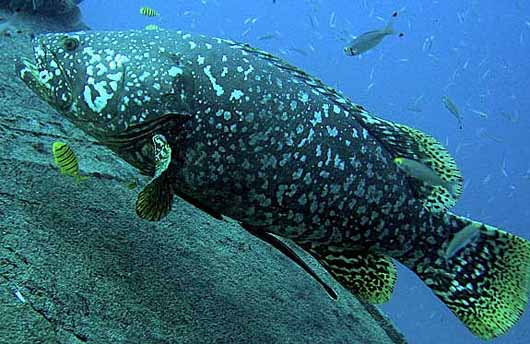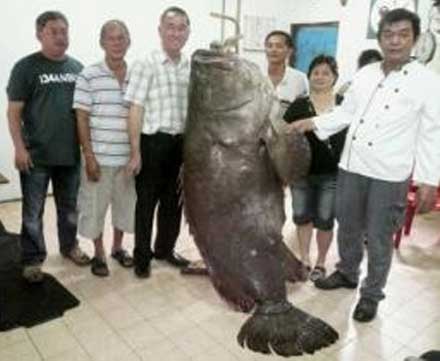Giant Grouper – Massive, Round, Dark Fish

The giant grouper is the largest bony fish found in coral reefs. It’s also known as the brown spotted cod and the Queensland grouper. In fact, it is the emblem of the state of Queensland, Australia. Groupers are a large family of fish and the giant grouper is one of the biggest in the family.
It’s found throughout the Indo-Pacific area except the Persian Gulf. They’re a huge species and can grow as massive as 9 feet (2.7 m) long and can weigh up to 1320 lbs (600 kg). There are rumors that even larger groupers have been found but these are unconfirmed.

The giant grouper is found commonly in shallow waters and feeds on a range of other marine life including small sharks, crustaceans and young sea turtles. Its favorite sea food is the spiny lobsters. Like other grouper species, it changes color as it ages. It has an extremely large mouth and a round tail. The young have uneven yellow and black markings whereas the adults are green, brown or gray with only a faint mottling. They also have a scattering of black spots on their fins.

These giants can live up to fifty years in the wild. They are fully protected as their numbers are dwindling. They breed between May and August and like many other fish they are hermaphrodites. They are a specific type of hermaphrodite known as the protogynous hermaphrodite meaning the young are predominantly female but turn into males as they develop. When young they’re believed to grow over 2 lbs (1 kg) a year. When they reach around 22 lbs (10 kg) they turn male and the male grouper has a harem of up to fifteen females. If there is no male in the group, the largest female will turn male to satisfy their reproductive needs.

The giant grouper preys upon other sea life but rather than chasing after its prey, it prefers to lie in wait and catch any prey unaware. But this slow-swimming, sluggish behavior isn’t good for them if there are spear fishermen around. Another threat is that their habitat is being destroyed by excessive fishing and its prey being wiped out. Similarly, the explosive devices used in reef areas have led to a decline in their population.
